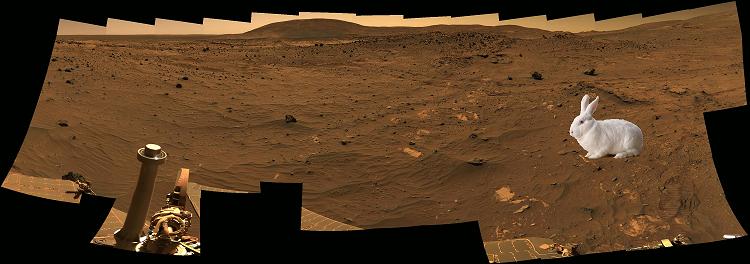
'No one would have believed in the last years of the nineteenth century that this world was being watched keenly and closely by intelligences greater than man's and yet as mortal as his own.... Yet across the gulf of space, minds that are to our minds as ours are to the beasts that perish, intellects vast and cool and unsympathetic, regarded this earth with envious eyes, and slowly and surely drew their plans against us.'
H. G. Wells, The War of the Worlds (1898)

My observations of the Red Planet. Of all my planetary observations I am most organized about making observations of Mars, and compile reports of my observations for the Mars Section of the British Astronomical Association. The reports themselves include tables of data, charts, drawings and maps. These can be found by following the links below:
MARS APPARITION AD2011-12
MARS APPARITION AD2009-10
MARS APPARITION AD2007-8
The rest of this page consists of my improving attempts to photograph Mars over the years.
[Under construction]
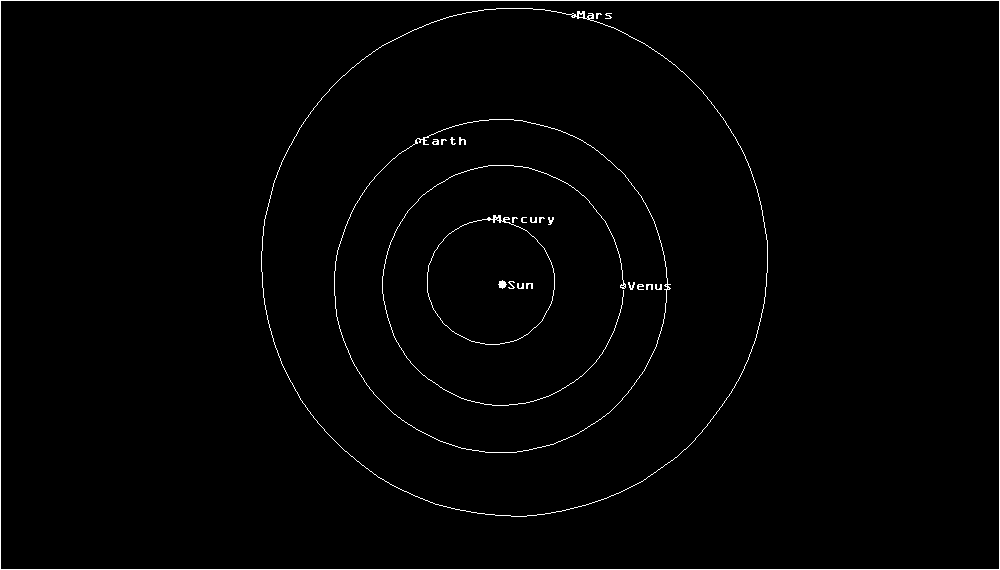
This chart shows the positions of the planets of the inner Solar System at the end of the study, with Earth having passed well by Mars on her inside orbit.
* * *
Observation #167, 2010.IV.17
At this time Mars was in the very near vicinity of the Præsepe or Beehive Cluster, and I took the opportunity to draw the event. It being twilight, only the brightest stars of the cluster were apparent.

Link to drawing of MARS and PRÆSEPE CLUSTER
2010.IV.17.2012 & 2019 UT
* * *
Observation #166, 2010.IV.11

MARS
2010.IV.11.2024 UT
* * *
Observation #164, 2010.IV.4

MARS
2010.IV.4.2030 UT
* * *
Observation #163, 2010.III.22


MARS
2010.III.22.2049 & 2115 UT
* * *
Observation #161, 2010.III.14

MARS
2010.III.14.1924 UT
* * *
Observation #159, 2010.III.6

MARS
2010.III.6.1916 UT
* * *
Observation #158, 2010.III.1


MARS
2010.III.1.2000 & 2022 UT
* * *
Observation #157, 2010.II.26

MARS
2010.II.26.1932 UT
* * *
Observation #156, 2010.II.21

MARS
2010.II.21.2054 UT
* * *
Observation #155, 2010.II.20


MARS
2010.II.20.2040 & 2100 UT
* * *
Observation #154, 2010.II.19

MARS
2010.II.19.2130 UT
* * *
Observation #152, 2010.II.9

MARS
2010.II.9.2120 UT
* * *
Observation #151, 2010.II.5

MARS
2010.II.5.2204 & 2210 UT
These were the last CCD images I took of Mars during the apparition. The dark triangular Syrtis Major is obvious to the left of the disc, with the neat ellipse of the bright Hellas basin above. Many other features are apparent, including the Sinus Meridiani and the north polar ice cap, although of course the detail is blurry. But most striking is the very bright plain east of (left of) Syrtis on the eastern (left) limb, brighter even than the Hellas plain, in the Æthiopis region. The Sun would be beginning to set over the plain at this time, so in retrospect it is not hard to imagine that the localized brightness is caused by the Sun catching evening cloud at the eastern limb of Mars, although at the time I did not notice any cloud. I imagine that the clouds at Martian sunset cannot compete with the colours of some of the clouds at sunset I have seen on Earth.


MARS
2010.II.5.2040 & 2231 UT
These are the two sketches I also took; the first shows the Syrtis Major still at midday, whilst the second shows the same region two hours later at mid-afternoon, closely corresponding with the time of both CCD images.
* * *
Observation #150, 2010.I.31


MARS
2010.I.31.2109 & 2308 UT
* * *
Observation #148, 2010.I.29
Mars finally reached opposition tonight and was directly opposite the Sun in the sky, although oddly, due to Mars' elliptical orbit, he was in fact closer to the Earth two nights ago. Still, at a mere 61,765,000 miles away, Mars subtended all of 14.09 arcseconds, and I managed to take the opportunity to capture the best image of Mars I have managed to date, with the north polar cap, Mare Acidalium, and the Great Southern Diaphragm all clearly visible in some detail. But the CCD camera which took these images is no match for the human eye and the interpretation of the human brain, and sketches taken at the eyepiece over many nights and hours of keen steady staring, are always far superior to photographs taken through the same telescope.

MARS
2009.I.29.2322-2332 UT


MARS
2010.I.29.2223 & 2010.30.0031 UT
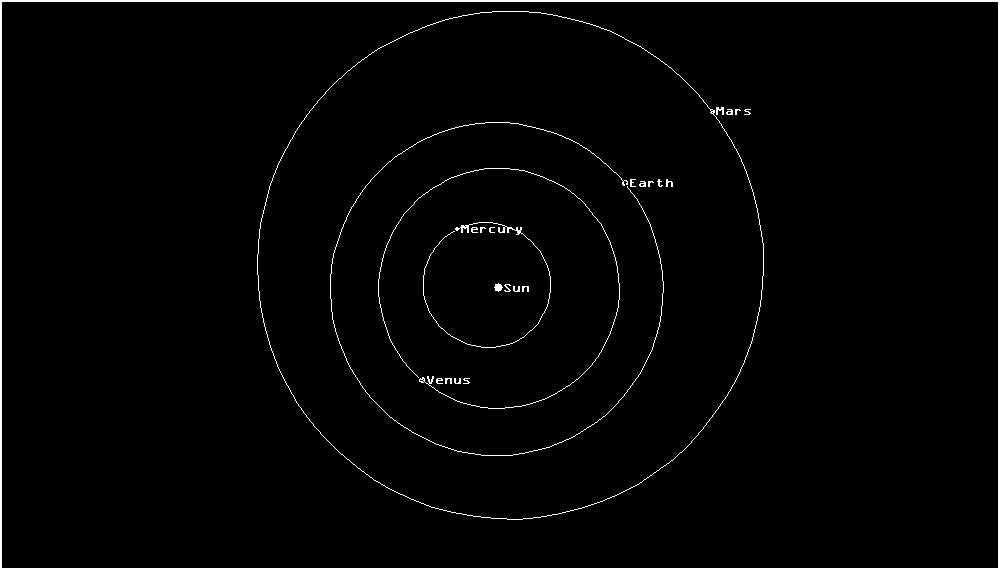
This map shows the positions of the planets of the inner Solar System with Mars at opposition.
* * *
Observation #147, 2010.I.27

MARS
2010.I.27.0052 UT
* * *
Observation #146, 2010.I.17

MARS
2010.I.17.2316 UT
* * *
Observation #145, 2010.I.9

MARS
2010.I.9.0313 UT
* * *
Observation #143, 2010.I.1

MARS
2010.I.1.0157 & 0210 UT

MARS
2010.I.1.0218 UT
* * *
Observation #140, 2009.XII.23




MARS
2009.XII.23.0148-0219 UT
Here the Mare Acidalium (the obvious dark ghost-shape in the northern [bottom] hemisphere of the planet) can be seen turning around the Martian globe from west to east (right to left) over the space of half an hour. Like the Lunar Maria, the Martian Mare Acidalium is not a sea at all, but unlike the basaltic basins of the Moon, Acidalium is a huge raised continental plain some fifteen hundred miles across, about the size of the Arabian Peninsula on Earth. Apart from the first drawing, made in natural light, each drawing is under a different colour glass filter, showing different levels of contrast in the surface features.
* * *
Observation #136, 2009.XII.17
This Observation #was taken just as a huge Siberian weather system had been forecast to dump heavy snow all over the British Isles. The weather forecast had shown a map of Europe with European Russia coloured dark blue (everyone had obviously already all frozen to death there) and everywhere to the west of Russia coloured pastel shades of light blue and yellow. It had also shown ominous large blue arrows sweeping directly from Russia across the Baltic and North Seas and towards Great Britain. A Weather Warning was issued predicting 'HEAVY SNOW', up to 10cm(!) and I was not sure if this was a joke or not. I was slightly apprehensive therefore, when, just as I was beginning my observations regardless of the weather forecast, the beautifully clear sky suddenly entirely fogged over. However, the forecast 'heavy snow' never materialised, and I was able to make observations of Mars and even take CCD footage through hazy gaps in the cloud. In fact, 'heavy snow' was forecast all through the week, and all that I ever saw of it was a chilly breeze with a couple of snowflakes on it. It seems that nowadays the Meteorological Office must be staffed by children who have never seen heavy snow, idiots, or lackeys of the oil magnates still trying to deny Global Warming. In any case, they obviously have no idea what 'heavy snow' means; to my mind, 'heavy snow' does not mean a soft carpet of snow 4 inches deep that melts away in a few days, 'heavy snow' means the sky being black at midday, and a heavy curtain of snowflakes of up to the size of a man's hand falling continuously in front of your eyes, so that you can just about make out your feet if you keep them moving. 'Heavy snow' means ten-foot snowdrifts that block your front door and trap you inside the house. 'Heavy snow' means people being buried alive and suffocating to death inside their cars. 'Heavy snow' means the country ground to a standstill, no one to be seen out of doors, and the snow waist-deep in the middle of major roads. 'Heavy snow' indeed.
And so now to checking the weather on Mars.

MARS
2009.XII.17.0401 UT
This was the image I managed to obtain through the #80A Blue filter, with Mars 77 million miles distant and subtending 11" of arc. The north polar cap (bottom) is plainly visible now. This cap is is made up of carbon dioxide ice which freezes out of the Martian atmosphere in winter, and sublimates back into the atmosphere as summer sets in, leaving a residual permanent north polar cap of water ice. I ought to explain that, whilst the Martian northern hemisphere is now in late spring and facing the Sun (and therefore the Earth in between) Mars himself approaches his furthest distance from the Sun in northern Martian summer and on the whole becomes coldest at this time, so the northern ice cap is still fairly large and covered with carbon dioxide ice. Meanwhile, at the other end of the planet, at the end of October just before the commencement of my study of Mars, night fell over the Martian south pole which is now in early winter. Winter night at the Martian south pole must now continue until November 2010, with the pole remaining permanently in darkness and pointing away from the Sun into deep space. So whilst the U.K. Met Office issues histrionic Weather Warnings for the sake of a couple of frosty nights and a few snowflakes on a chilly breeze here in Great Britain, the already hostile conditions at the dark Martian south pole must be quickly becoming entirely frightful, and temperatures must fall to something like 150 degrees centigrade below zero before the year-long winter is through.

MARS
2009.XII.17.0417 UT
This sketch shows the major features on the Martian disc. The shape of the Mare Sirenum is clear at the top of the drawing, as is the extension of the Mare Boreum from the northern arctic at bottom into the desert of Arcadia. I suspect that the remaining feature to the right of the disc is the Trivium Charontis.
* * *
Observation #135, 2009.XII.12

MARS
2009.XII.12.0232 UT
* * *
Observation #134, 2009.12.8

MARS
2009.XII.8.0332 UT
* * *
Observation #133b, 2009.XII.5

MARS
2009.XII.5.0636 & 0647 UT
The Syrtis Major is the most prominent feature on Mars and is plainly visible here as a dark triangular shape in the centre of the disc extending from the south (top) to centre, merging with northern hemisphere detail. The great desert-filled basin of Hellas above the Syrtis Major is the brightest feature on Mars, and in this image it is so bright that it looks somewhat like a southern polar hood (top). However the south pole is tilted away from the Earth and is not visible from this angle, although the north polar cap (bottom) is plain to see.

MARS
2009.XII.5.0621 UT
* * *
Observation #132, 2009.XII.4

MARS
2009.XII.4.0331 UT
* * *
Observation #131, 2009.XII.1

MARS
2009.XII.1.0320 UT
* * *
Observation #128, 2009.XI.22

MARS
2009.XI.22.0339-0424 UT
Six days since my last Observation #and Earth was 4,000,000 miles closer to Mars, with Mars 94,000,000 miles distant and subtending 9.2 arcseconds. The footage is clearer, with Acidalium apparently moving across the face of the disc. I think.
* * *
Observation #127, 2009.XI.17

MARS
2009.XI.17.0403-0417 UT
My first ever CCD footage of the planet Mars under different coloured filters, with the planet 98,000,000 miles away and subtending almost 9 seconds of arc. Although this footage is disappointing, the north polar cap is fairly obvious at the bottom of the disc, and some subtle shading can be seen, particularly the Mare Acidalium in the northern hemisphere where the disc falls into shadow.

MARS
2009.XI.17.0434 UT
This sketch shows the major features, but the detail is vague.
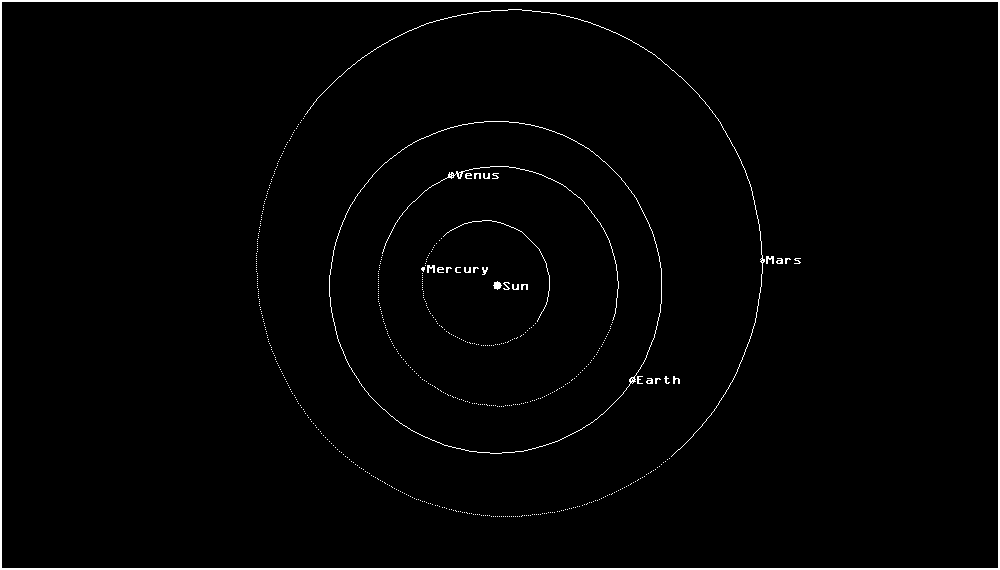
This map show the positions of the planets of the inner Solar System at the beginning of my study of Mars for the 2009-10 apparition.
Observation #44, 2008.II.12

MARS
2008.II.12.2252 UT
Mars was really beginning to shrink at this time, subtending 11" of arc, and within a month I had stopped targeting him. Making this Observation #brought home to me how difficult Mars is to observe telescopically, and of how much of an opportunity his infrequent apparitions present to astronomers.
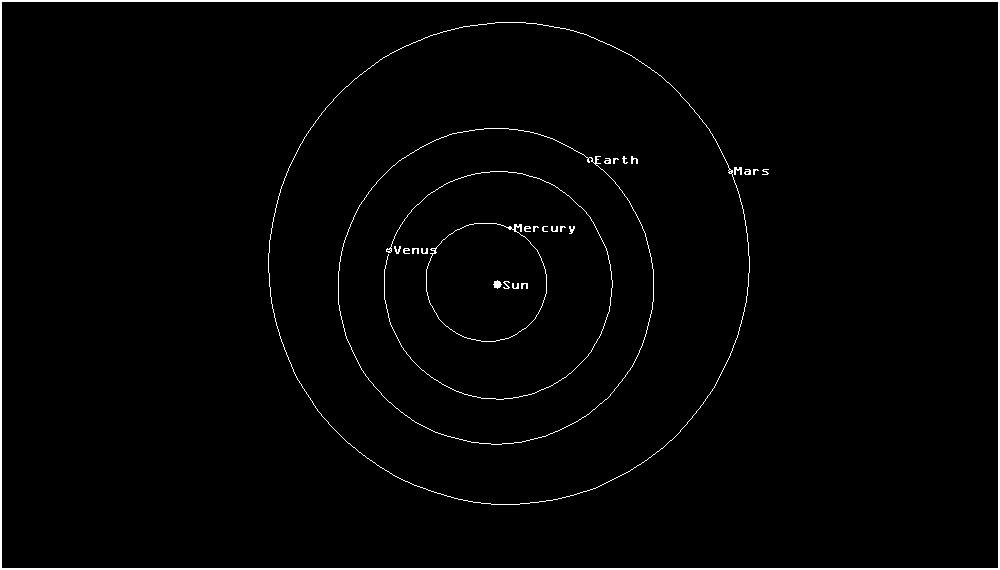
This map shows the relative positions of Earth and Mars when my study of Mars ended on 12 February 2008.
* * *
Observation #39, 2008.I.29

MARS
2008.I.29.0017-0119 UT
Good-medium seeing, Antoniadi II-III.
0017 UT
Mars now a month after opposition is only subtending 12" of arc. Having fixed the collimation as well as I could, the Martian disc was fairly clear although some fine tuning is still necessary as the glow around the disc at full aperture is off-centre. At 1½" aperture the disc was fairly perfect. Very difficult indeed to make out any detail; even with the #21 orange filter (almost impossible to see anything through #25A red). The Great Diaphragm of dark markings running right around the planet south of he equator appeared as an hour glass-shape, the western end of which being the great Syrtis Major plateau, the most prominent and obvious feature on the planet. The great basin Hellas extended into the southern side of the hour glass-shape as a brighter area, and the darker Mare Hadriacum was visible bounding Hellas to the east. Boreosyrtis was also visible as a darker shadow on the northern limb of the disc, and possibly a small darker feature was in evidence between this and the Syrtis Major, although this only presented itself in a single moment of clearer-than-usual seeing. Nodus Alcyonius perhaps? Impossible to make out any definite outline to any of these features in any case, neither could I see any polar ice with the #80A blue filter. The polar caps shrink at this time of year on Mars (northern spring/southern autumn) and neither pole is facing the Earth in any case. (In fact one must observe Mars over eight or nine different oppositions over fifteen or seventeen years to observe the full cycle of the Martian seasons and their effect on the Martian globe.) Finally, if any weather systems were visible, such as cloud cover or dust storms (which I believe are seasonal on Mars at this time what with the ice caps evaporating) I failed to observe them.
Took some mobile phone footage which vaguely corresponded to my sketch, although the Syrtis Major was practically 'brighted' out. Processed this footage on computer some months later; the result is not entirely unlike my sketch, although doubtless my sketch was more accurate.

MARS
2008.I.29.0040 UT
* * *
Observation #32, 2007.XII.12

MARS
2007.XII.12.0431 UT
Probably the best view of Mars I was able to obtain around the time of the last interplanetary pass at Christmas 2007. Mars will next be at closest approach in January 2010.
* * *
Observation #31, 2007.XII.11.0509

MARS
2008.XII.11.0509 UT
* * *
Observation #27, 2007.XII.3

MARS
2007.XII.3.0539 UT
* * *
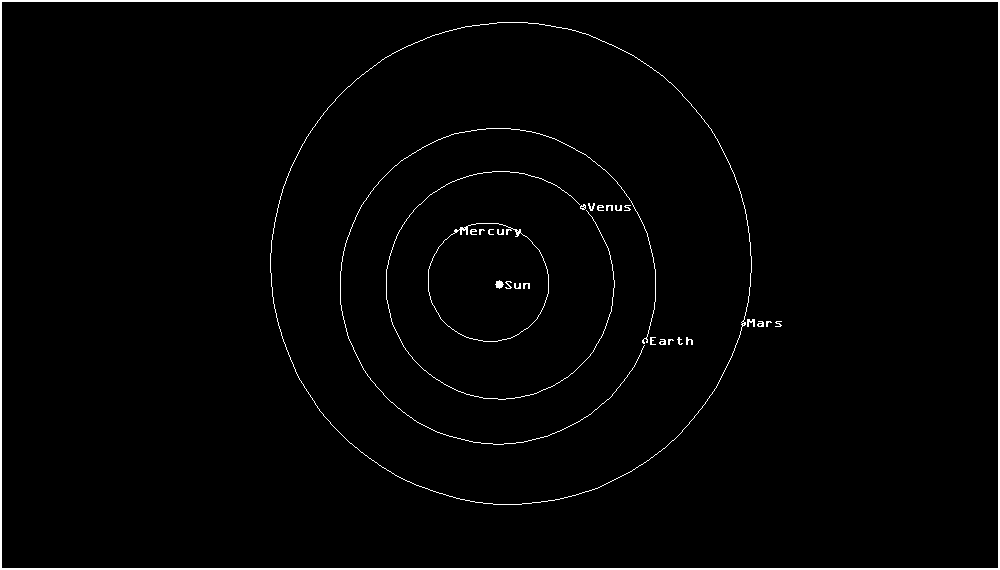
This map shows the relative positions of Earth and Mars when I started observing Mars on 1 December 2007.
Observation #25, 2007.XII.1
Good seeing, crisp clear morning after a rainy overcast night. Antoniadi II or III perhaps.
0619
At last Earth is nearing a close approach to Mars, and it is now possible for me to observe him with a telescope for the first time. Having waited some days for the weather to clear, and having fallen asleep with it raining outside last night, I happened to wake up early this morning and look out of the window to see Mars hanging high in the west in a perfectly clear sky. And so for my first ever telescopic view of Mars, now less than 58 million miles distant.
Some trepidation, and then first views very disappointing, exactly like looking at a bright, blurry and featureless red lentil held at arm's length. In spite of it being a clear morning then, at 400× magnification the image was unclear, and very foggy indeed under the #80A blue filter, and after a brief process of trial and error I elected to reduce to 160× magnification without the filter, and with the aperture cover on with a single 1½" aperture left open in it. The #80A blue filter is only useful in observations of Mars for bringing out the Martian polar caps of frozen carbon dioxide or dry ice. However, the Martian southern hemisphere (with greater extremes of climate than the northern) is - I believe - in late autumn at present, and the northern hemisphere is in late spring. Therefore I suspect that temperatures at both of the Martian poles are too warm to produce extensive ice caps at present. Furthermore, Mars is neither presenting his northern nor his southern hemisphere directly towards the Sun at present (and therefore not directly towards the Earth either, which lies roughly between Mars and the Sun at present) making it difficult to observe either pole. In any case, I was unable to observe any definite polar ice. However, after I finished observing at dawn I noticed that the #80A blue filter badly needed cleaning, and having cleaned it now I will try it again the first opportunity I get.
In spite of the severe difficulties obtaining a clear image, and in spite of the smallness of the image, some detail was visible and I was able to observe two major and three minor features on the small image of Mars that presented itself. To the south, two obvious large dark patches tapered in from either side of the disc, and checking a map now I see that the easterly of these can only be the Mare Sirenum, whilst the westerly is the Mare Cimmerium. It is difficult to work out exactly what it is I've observed with the information available to me at present. The way I understand it (having just observed them) Mare Sirenum and Mare Cimmerium are merely classical names given to dark markings which, prior to the exploration of Mars by remote probes, were assumed to be seas, just as the obvious dark areas of the Moon once were. However, whilst the Lunar 'seas' or Maria have kept their original names, it would seem that since the Space Age the Martian Maria have been reclassified as Terræ or 'lands'. For the sake of consistency with Lunar nomenclature and of good taste however, here I shall stick with the more romantic usage of Maria. As to the nature of these dark markings, I gather that they frequently change appearance appreciably, due to their being covered and then uncovered by dust storms that sometimes sweep the entire planet; also that the sand analysed by the 1975 Viking probes was finer than talcum powder, and was just that, sand or silica, with oxides of metallic elements, mainly iron, giving the sand its red colour; whilst the rocks analysed by the 1996 Pathfinder mission were mainly basaltic. Looking at a relief map of Mars made using a remote orbiting spacecraft then, I saw that although the dark areas did not directly show up on the relief map, they roughly corresponded to regions of obviously higher ground. I assume then that the dark areas are raised continental plateaux of dark volcanic rock, or areas of rough, rocky or mountainous terrain that absorbs and/or deflects a lot of the sunlight that falls upon it. Thus the bright, more reflective red areas are the vast, relatively smooth low-lying deserts of fine red sand like brick dust, strewn with boulders, as seen in the Viking photographs of the Martian surface. The deserts are occasionally whipped up into dust storms (which can be seen from Earth) which finally settle over some of the darker areas of naked basalt, and change their shape as seen from the Earth. One wonders what a Martian astronomer might have made of Earth's continents, had humans evolved on Mars. 'Beneath the constantly changing white cloud cover can be traced the definite outline of regions of high albedo, lighter areas which were originally thought to be low-lying deserts. Of course, we now know that these are in fact higher ground, and that the extensive darker surface tracts are not basaltic uplands but vast basins in the crust of the planet, filled with what is thought to be liquid water.... What a dump. Don't those stupid Earthlings ever get tired of prancing round and round in the same circle like simpletons, singing Jingle Bells once every time round?'
I have looked at a number of different maps of Mars made in different decades, most of them hand-drawn by Earth-bound astronomers over months and years of dedicated painstaking observation, and none of them are identical or position the named regions in the same places; the appearance of the Maria Sirenum and Cimmerium vary considerably between maps, on some maps they are even conjoined, and obviously this variation must be due to the Martian weather and shifting sands. When I observed them myself, I believe that there was a marked separation between the two Maria, with a small dark area between them, closer to the edge of the Mare Cimmerium and slightly to the south of it, and this was one of the minor features I also noted. Another minor feature was a small rather dark feature curling across the east of the disc, above the Mare Sirenum, roughly corresponding to the area between Thyle I and Phæthontis, closer in to the Martian south pole. The south polar region was the only region which might have showed evidence of (dry) ice; being partially cut off from the rest of the disc by the two dark areas, it gave the appearance of being slightly brighter than the rest of the disc at times. I shall check again with the (clean) #80A blue filter at the soonest opportunity. Finally, the northwestern edge of the disc was apparently more in shadow than anywhere else around the edge of the disc; this must have been a dark marking at the edge of the Ætheria/Utopia region.
My description is by necessity vague, one must bear in mind that the images that I observe at my telescope are generally of very poor and continuously varying quality, and I struggle to pick out any details at all. Observing Mars through a respectable amateur telescope is - for me at least - marginally more difficult than picking out the details on an old cricket ball from at least ten or twenty yards away (with my glasses on). But I believe that this is a problem common to all observers of Mars, and that many terrestrial observations are made only after long hours spent at the eyepiece following the same image, and of having observed the same faint features occasionally standing out in moments of clarity as they slowly revolve around the Martian globe. For many years, astronomers with far larger telescopes than my own reported canals on Mars which simply were not there and were tricks of the eye. And I have seen it written that an experienced observer may pick out details which a beginner with a telescope five times as powerful would miss altogether. At the end of it, I've pointed a bucket with a shaving mirror and a compact mirror in it at a red point of light in the sky, looked at the result through a magnifying glass, seen a small reddish disc with two or three vague dark markings on it, and somehow managed to type up a page and a half of small print about it.
Before Mars reaches closest approach (54.8 million miles) around 24 December I ought to have acquired Wratten #21 orange and #25A red filters to reduce the glare of the Martian disc, which hopefully will bring out more detail in the dark markings. If the weather stays clear for any length of time, I shall attempt to observe some of Mars' rotation by the dark markings on its disc. In forthcoming weeks, if either of the ice caps become apparent as the Martian northern winter begins, I shall also acquire #12 yellow and #58 green filters to monitor the edges of the ice sheet.

MARS
2007.XII.1.0619 UT
You may return to the index page now. No one need ever know that you were here.